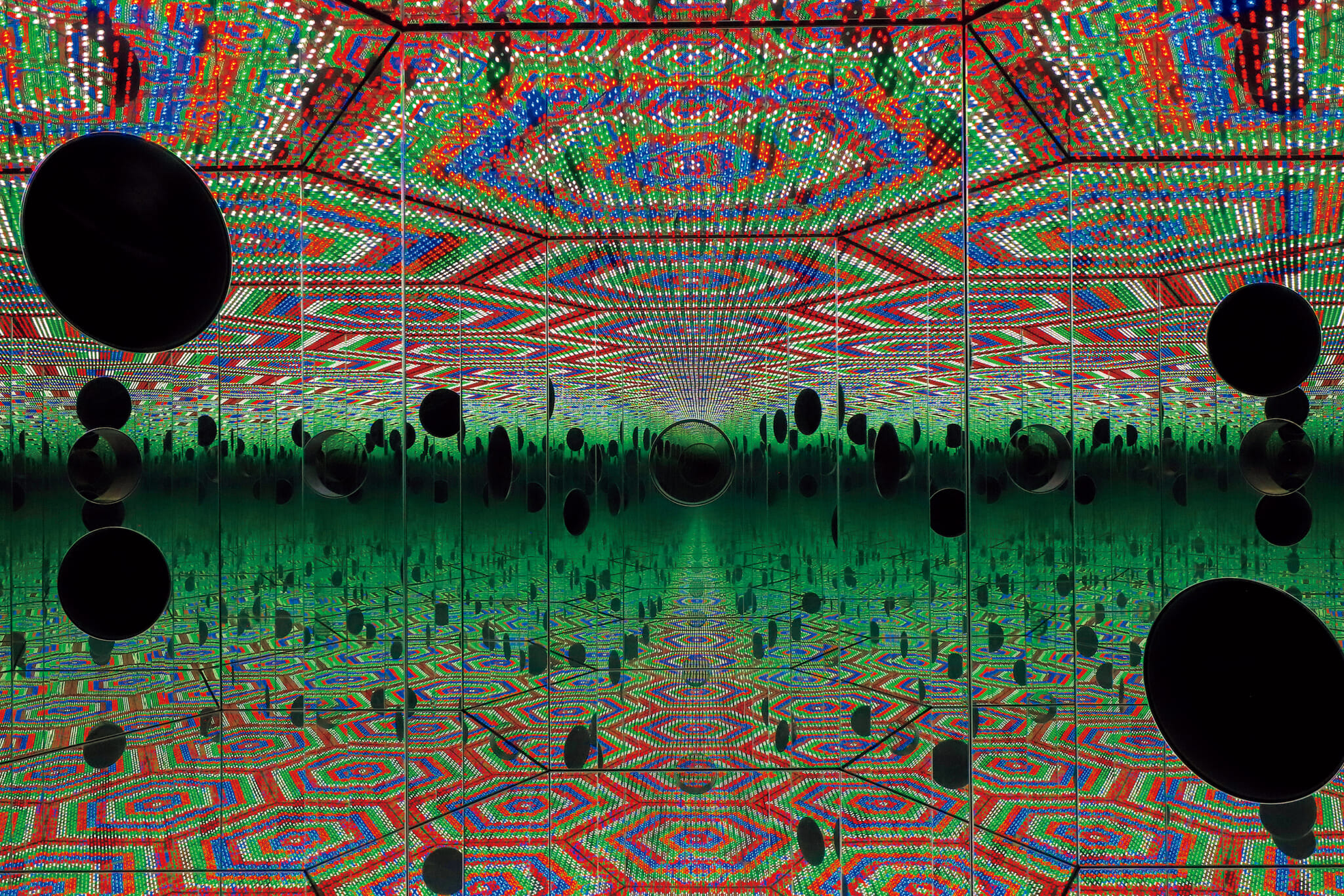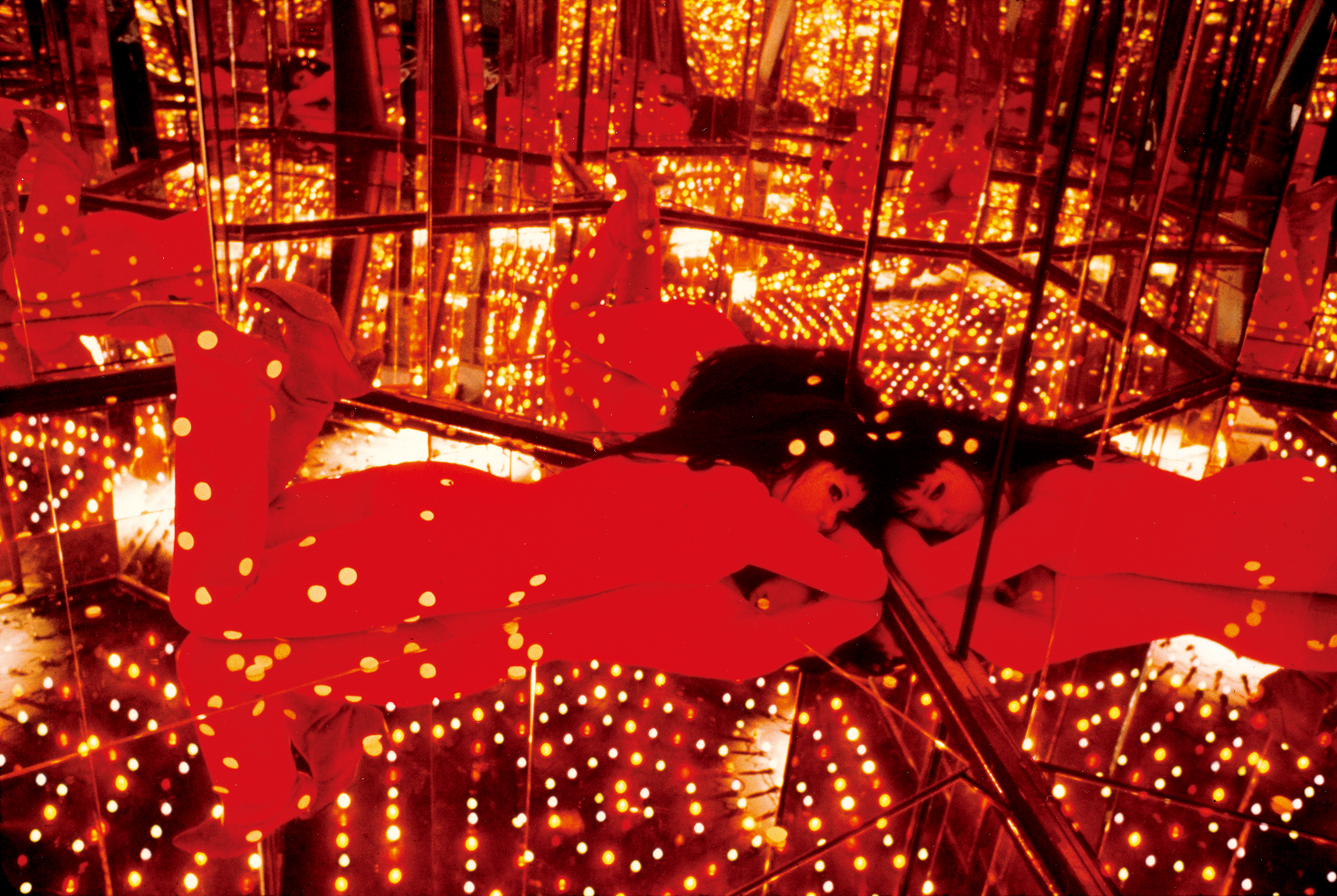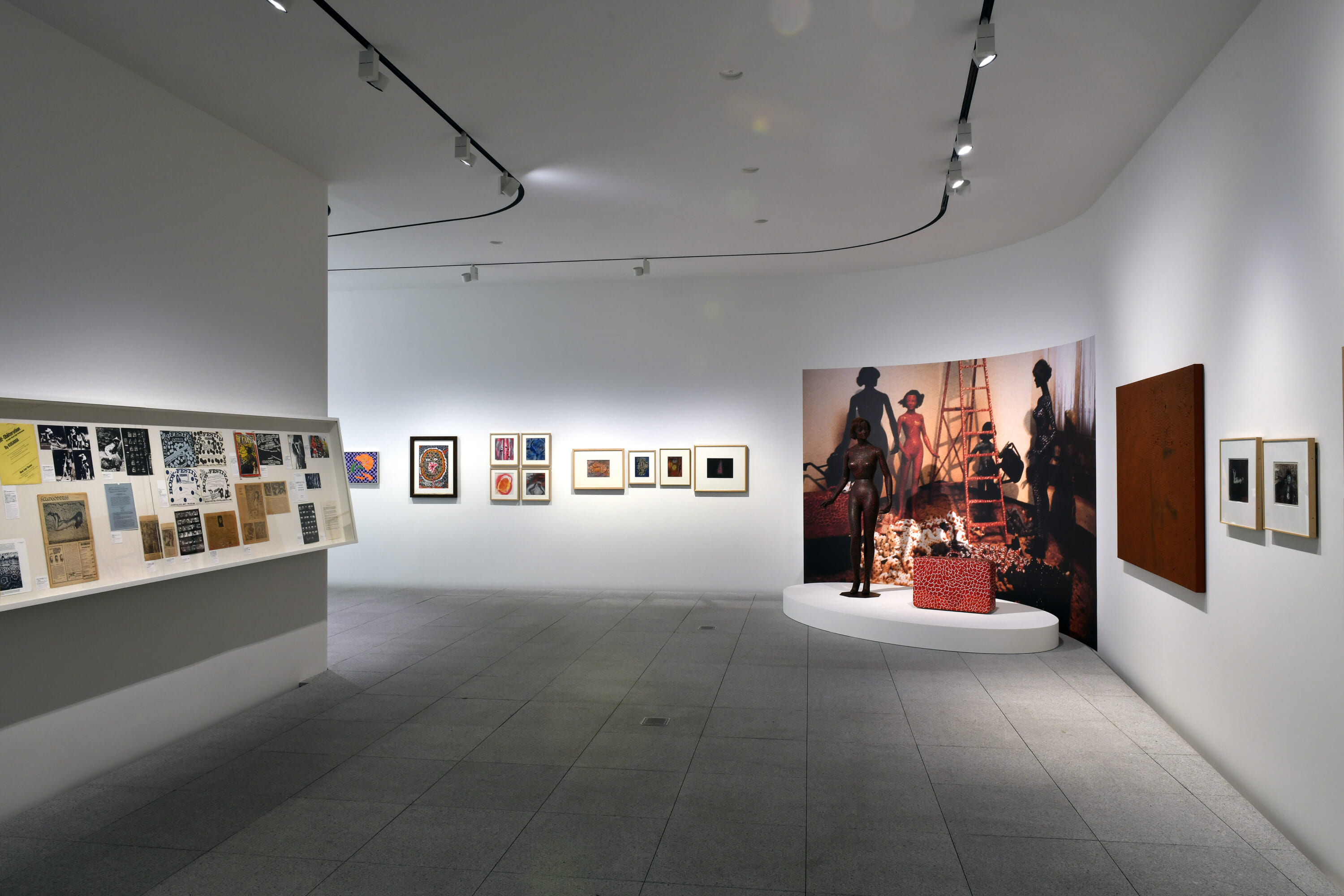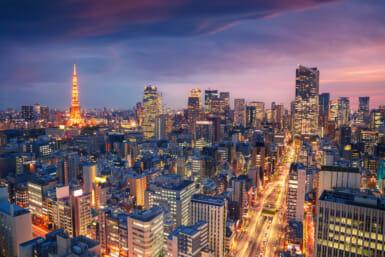The “Yayoi Kusama’s Self-Obliteration/Psychedelic World” exhibition at The Yayoi Kusama Museum offers viewers a captivating and relevant exploration of the artist’s core philosophy. Spanning her early works in Japan, her involvement in America’s psychedelic art movement, and her later works after her return, the latest exhibition delves deep into Kusama’s central concept of self-obliteration. The exhibition blurs boundaries of existence by inviting viewers on a journey of self-discovery and universal unity through diverse mediums, including paintings, installations, films and literary pieces.
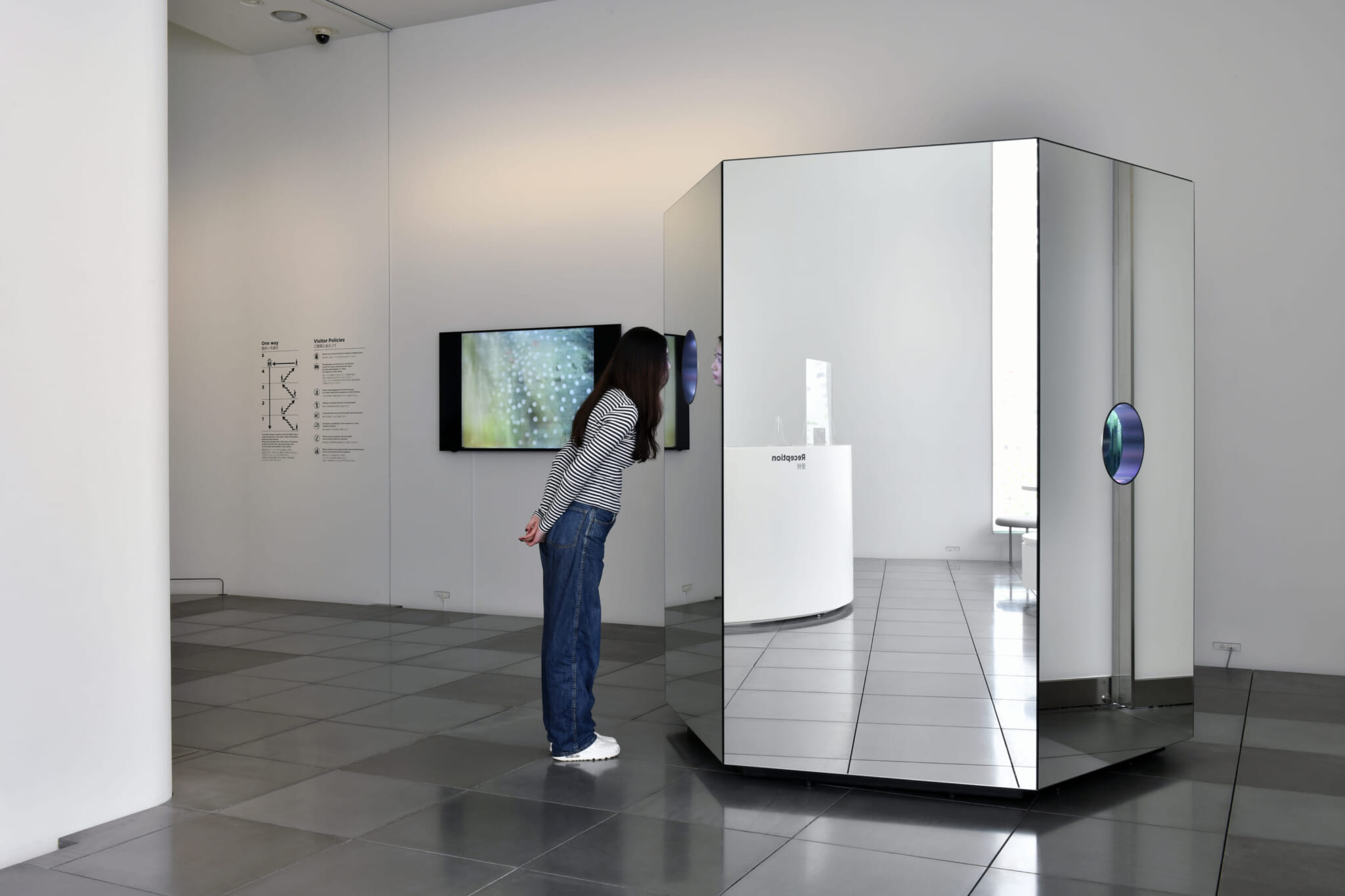
1F Installation view, © YAYOI KUSAMA
Peeking Into a Kaleidoscope Mirror Realm
On the museum’s first floor, the viewer is invited into Kusama’s exploration of altered physical and psychological scapes through her 1967 film Kusama’s Self-Obliteration. The film captures the pivotal New York period and includes footage of her works in the 1950s and 1960s. Under Kusama’s direction, the footage elicits a drug-like trance through a periodic cacophony of color, lights and flashing scenes — the artist’s iconic dots are present — pixelating the sentient and non-sentient, unifying everything around into one infinite cosmic organism. Kusama is not merely documenting her public ‘happenings.’ The video is another altered space where she allows the present viewers to time-travel into the psychedelic head spin of the moment, becoming witnesses to the artist’s profound quest to dissolve the boundaries of one’s self.
The first floor is also the stage for the world premiere of the 94-year-old artist’s breathtakingly-named kaleidoscope mirror piece “Each and Every Wish for Peace Just Shines” (2023) from Kusama’s Mirror Room series. Whereas the film draws us into Kusama’s visionary realm, priming the viewer to enter the center of the psychedelic period, the current exhibition summons gallery-goers to self-obliterate before ascending to the subsequent gallery floors. Akin to how viewers transformed into the art in the video, the installation calls for everyone to partake in the creation.
Kusama first developed hexagonal mirror and electric light pieces in the 1960s. She poignantly revisits this concept in this 2023 piece. Peeking into holes, viewers discover an infinite expanse of reflections, identities merging into a psychedelic landscape to become part of Kusama’s cosmic kaleidoscope. In this piece, Kusama honors each and every wish for peace thereby not devaluing the individual in the act of dissolution, instead advancing a transcendent universal interconnectedness. The repetitive fragments of self create a sense of infinity and dissolution. Faces become a dazzling shared happening that only the participants can witness as they become integral to a shared, mysterious, grand design. The experience is a reward for willing to peek into the unknown. Through these captivating experiences, the first floor prepares the viewer to embark on a transformative journey of the artist’s ongoing pursuit of self-obliteration.
Understanding Kusama’s Self-Obliteration
As viewers ascend the staircase and enter the second floor, video and archival articles display an intimately formative period in her practice. These entry pieces underscore how Kusama’s happenings played a pivotal role in pushing her experimentation with self-obliteration by challenging the notion of physical and conceptual boundaries while redefining the concept of public spaces. Kusama continued to make art in this spirit, even after returning to Japan in the 1970s. Intriguing is the repeated representation of polka dot-covered mannequins and suitcases seen in sketches, archival photographs and installations. It seems that mannequins are guides that model a relationship with the surrounding world that transcends the notions of reality and the artificial, questioning the authenticity of human existence. The suitcases, often placed among the figures, evoke a sense of wanderlust for an unseen reality.
This wanderlust leads to the third floor of the exhibition, offering unique insights into Kusama’s artistic vision of self-obliteration in the late 1980s and early 1990s. The expansive acrylic painting “Revelation from Heaven (B)” (1993), engulfs the viewer, with its monumental size, evoking a psychedelic sensation of hurtling through the cosmos, into the vastness of the universe. Nearby, there’s the mesmerizing world premiere of 22 small-scale acrylic paintings from the late ’80s, utilizing psychedelic optical transformations and employing vibrant colors and shapes that create an illusion of movement and distortion.
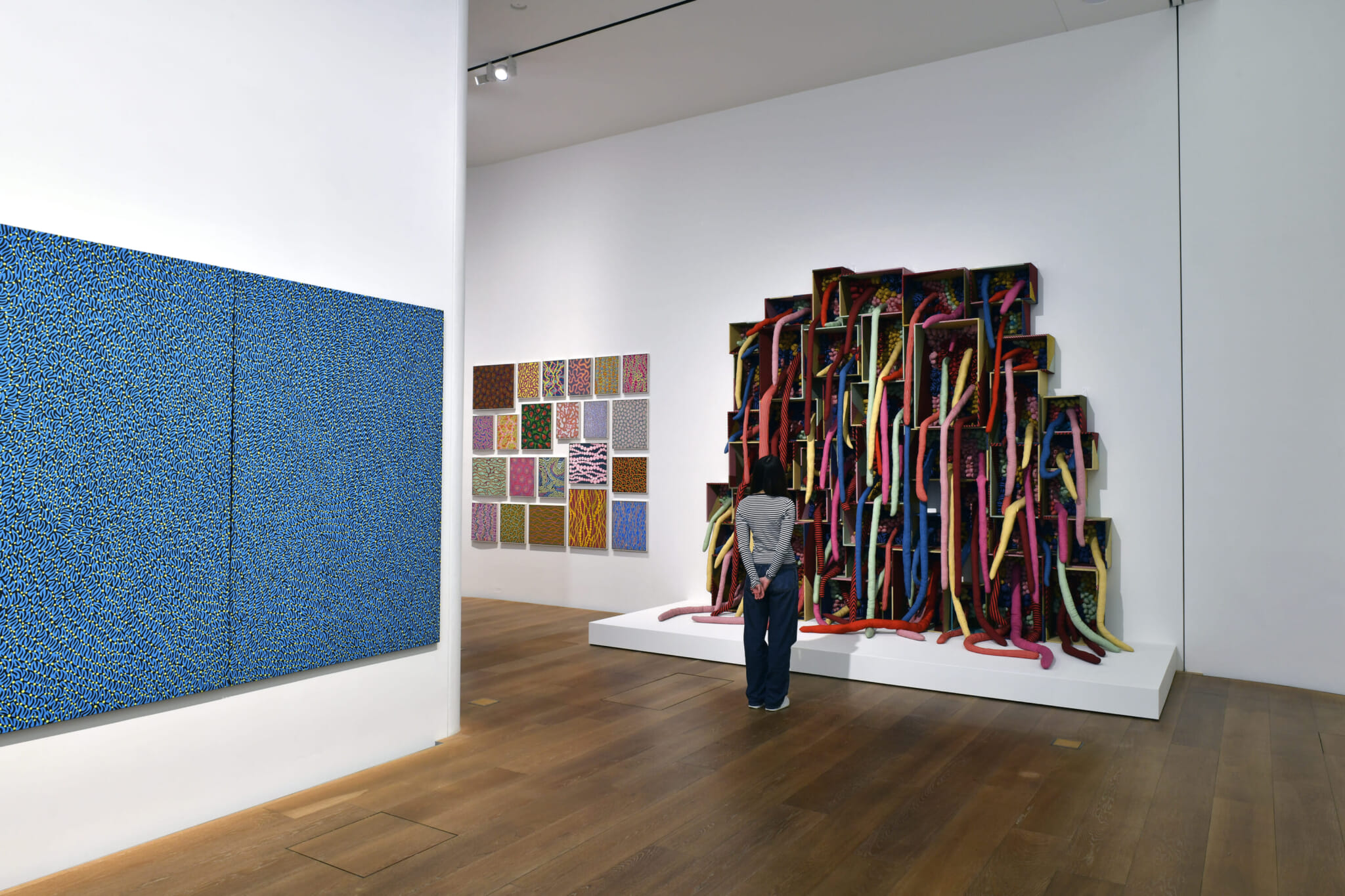
3F Installation view, © YAYOI KUSAMA
Although Kusama’s polka-dots have become emblematic of her art, the tubular form is present throughout her career, seen wriggling in her collages like “Self-Obliteration #3″(1967), “Self-Obliteration #4” (1967), and identifiable in many of her drawing and acrylic paintings like “Leaves” (1954) and “Festival” (1988). The tubular form can no longer be ignored in “The Return to Eternity” (1988-91). This startling, triumphant, mixed-media soft-sculpture work features large-scale, entangled tentacles squeezing outwards from boxes, threatening to pour onto the gallery floor.
I was prompted to contemplate Kusama’s stolen self, reminded of her soft sculptures being appropriated in the U.S. by a leading artist. This appropriation led to a mental crisis amid her psychedelic phase. Kusama’s history includes multiple events of her being erased — each time forcing her to confront thoughts of self-elimination. In “The Return to Eternity,” I felt the artist taking back control from other-enforced destruction by allowing the self to be brokering its own obliteration through these soft tentacles.
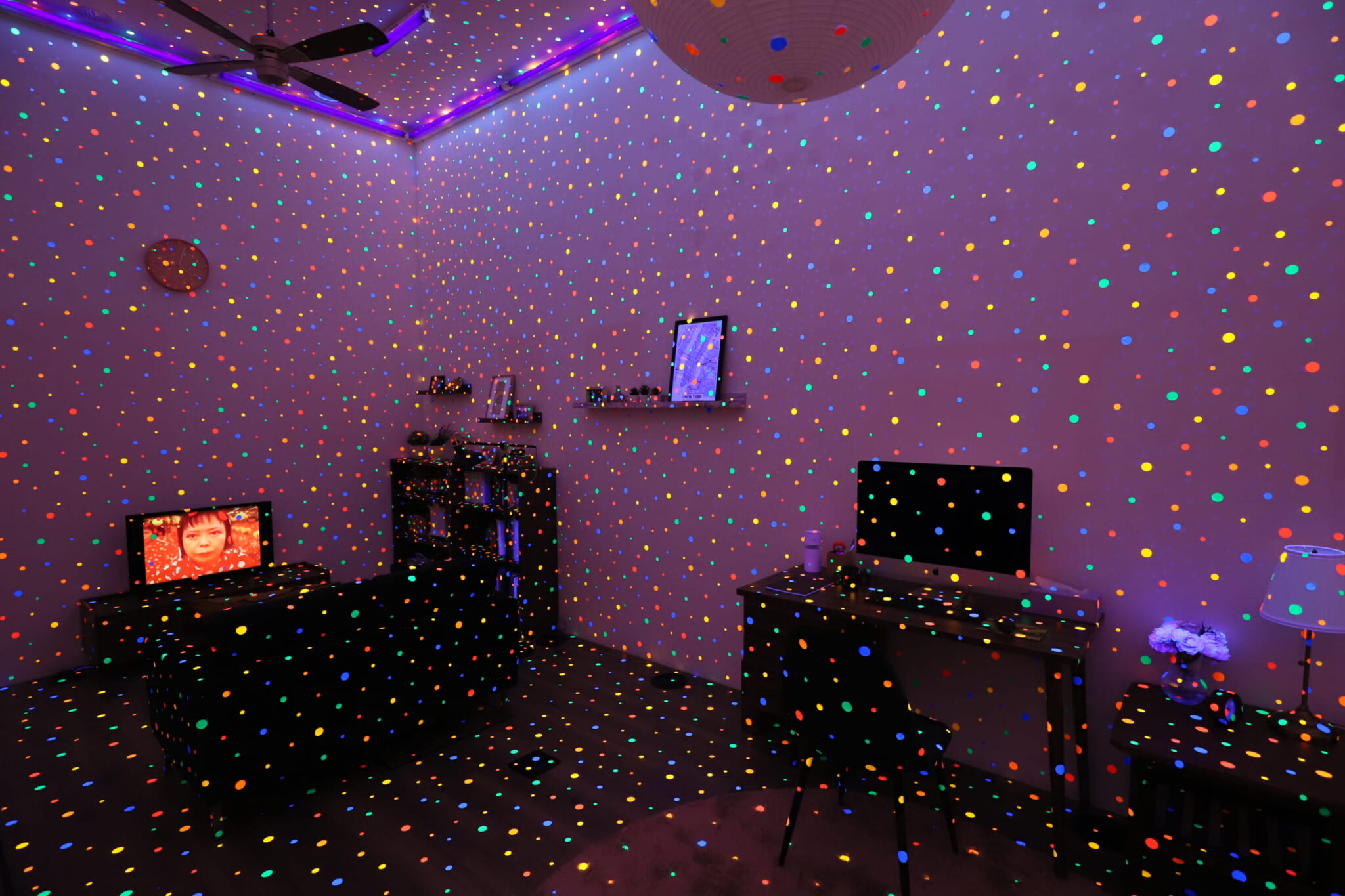
I’m Here, but Nothing (2000/2022), © YAYOI KUSAMA
Enduring, Blossoming
Ascend to the fourth floor where the room installation titled “I’m Here but Nothing” (2000/2022) is located. Here, visitors become one with Kusama’s hallucinatory experiences. The mesmerizing interplay of fluorescent lights obscures the barriers between self and surroundings, altering them into vibrant polka dots. Adding to the richness of this examination of Kusama’s philosophy is a compelling slide show of Kusama’s novel from 1978, titled Manhattan Suicide Addict. This evocative literary work offers invaluable insights into the artist’s environment and psyche during her time in New York, providing a window to ongoing exploration of self-obliteration before the viewer makes their way to the rooftop.
Elevated with most of the exhibition below and the sky above, the life-sized outdoor sculpture, “Flowers That Bloom at Midnight” (2010), becomes a comforting companion. Having traversed the immersive realms of self-obliteration through diverse mediums and spaces, the blossoming petals of a magnificent, friendly flower, assuages self-obliteration fears. One envisions opening up to the vastness of the universe, becoming intertwined with humanity.
It is a poignant reminder that Kusama’s self-obliteration leads to a profound connection and harmonious existence with the world. These are the very sentiments of “Each and Every Wish for Peace Just Shines” with which this exhibition’s journey began.

